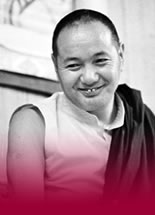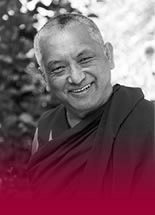Robina’s Blog
4 February, 2021
We really begin to practice when we learn to be our own therapist, as Lama Yeshe puts it: seeing our mind, noticing the anger, the attachment, the fears, and learning to work with them and change them. That’s the real, immediate practice to do. And this is what’s so difficult.
We have sensory consciousness and mental consciousness, so where do these parts of our mind exist? The mental consciousness. That’s where the workshop is, as Lama Zopa Rinpoche says. That’s what we have to become familiar with, that’s what we have to get to know deeply, and that’s where we have to be our own therapist. And that’s what we have to change, because that’s where the potential for enlightenment is. And that’s where all the potential for suffering is.
This is the point. So even beginning to recognize that our sensory experiences and our mental consciousness are fundamentally different is crucial, because then we don’t get fooled by what the senses tell us. It’s an extremely important point in order to become a good practitioner.
Negative and positive states of mind
According to the Buddhist model of the mind, we divide the contents of our mental consciousness into three categories; there’s no fourth. There are the so-called positive states, the negative ones, and neutral – I like to call them the mechanics of our mind. Examples of these are concentration, mindfulness (which really means not-forgetfulness), discrimination, alertness, attention, intention, and so on. These are vital states of mind that enable anyone to function properly – whether you’re a murderer or a meditator. Remember, we’re not discussing the brain here. Buddha doesn’t talk about the brain, he’s talking about the cognitive process itself: thoughts and feelings and emotions.
The virtuous ones like love and compassion are altruistic, are the source of our own happiness, and cause us to want to help others.
The negative ones are necessarily I-based, totally self-centered and in their raw form really neurotic, really delusional, and really disturbing; and they’re the source of my suffering and, of course, the source of why I harm others.
Negative states of mind have two main functions
There are two main characteristics that the negative states of mind have. One is indicated by the term disturbing emotion. So even if we became familiar with just this, it would give us great courage to want to go beyond it because this is what suffering is. Just the suffering of being angry, just the suffering for yourself of being jealous, being depressed. It’s so obvious, isn’t it? It’s so clear that it’s so painful for us.
Another characteristic, and this is the really tasty bit, is that these negative states of mind have is that they are delusions. What Buddha’s saying is that the extent to which we’re caught up in depression or anger or attachment is the extent to which we’re out of touch with reality.
If someone accused us of being delusional, we’d be very hurt. But Buddha is saying exactly that.
We need to clearly distinguish
The Buddhist model of the mind is very clear in distinguishing between these positive states of mind and the neurotic ones, the negative ones. Buddha’s main finding, as I mentioned, is that these negative states, these neuroses – he would have liked that term, I think – are adventitious; they do not belong in the mind and thus we can get rid of them.
The positive ones, we all know: love, compassion, kindness, generosity, forgiveness, self-confidence. As soon as we hear those words we go, “yeah, that’s great,” whether we’re on the receiving end of them or whether they’re inside us. We know they’re the good stuff. Then you’ve got the stuff that’s miserable: we know depression, jealousy, low self-esteem, self-hate, anger, arrogance. These, we know immediately, aren’t cool.
Therefore, we need to know our mind because what goes on in our mind is the main source – the main source – of our happiness and suffering; and because we need to rid the mind of these causes of suffering. That’s what Buddha means by “nirvana.”
Effectively attachment is the main source of our pain
The Buddha’s view is that actually the basis, the source, of our day-to-day suffering is attachment. If that’s true, then clearly we’d better know what he means by it. Otherwise, as Lama Zopa Rinpoche says, when you hear that Buddha says you’ve got to give it up, you’ll go, “Oh, I’ve got to give up my happiness? I’ve got to give up my heart?”
This is really difficult because when we use even this word in our culture we use it interchangeably with the words love, happiness, joy, pleasure. So please, throw out all your definitions, all your assumptions now and listen to this view, because Buddha uses this word in a very specific way.
I remember Lama Yeshe saying one time, “I could tell you about attachment for one whole year, but you’ll never begin to really understand it until you start to look deeply inside.” This is interesting. “Attachment”: it’s such a cute word, a simple word. We use it in our culture, but in a very different way. So it’s really important when we hear Buddha’s views about attachment we understand clearly what he means by it.
For us it’s virtually synonymous with closeness, love. But for the Buddha it is very, very different. If you want to understand what Buddha’s saying, you’ve got to know what his definition is. And we’re not used to thinking this way, you know? If we think about it, even just the word “love” – if everybody reading this gave their definition, we’d have as many meanings as people, and we tend to think that’s okay. No wonder we don’t communicate!
I mean, if everybody had their own view about what one plus one was, we’d all be in serious trouble, wouldn’t we? “I’m allowed to think it’s seven!” We wouldn’t say that. We communicate nicely when it comes to numbers; you can’t get it wrong. But if I say “I love you” and you say “I love you” – wow, we think we’re communicating! But we’re not, because we have different definitions, different assumptions. When it comes to emotional stuff we’re very wishy-washy in terms of what we mean by words.
Attachment is one of the deepest neuroses for the Buddha. But why and how? When you say, “My god, she’s so needy,” straightaway we know that’s not pleasant. “What a control freak he is.” “Oh, she’s so possessive.” Well, these are some of the characteristics of what Buddha refers to as attachment. It’s multi-faceted.
The more we get, the more we want
Another function is we’re always hungry for more. But you know what? That’s the junkie mode. We’re never satisfied. We truly believe that when I get it then the satisfaction will come. It’s like an ache, a pain and I’ve got to get that thing to assuage the pain. So we’re all junkies, it’s a question of degree. We’re all deluded; it’s a question of degree. We’re all insane; it’s a question of degree.
Attachment is the source of most of the other unhappy emotions we experience in daily life – like anger and jealousy and all the rest. It’s deep in our bones. At the most primordial level, it’s the deep feeling of dissatisfaction. We’re never satisfied: no matter what I get, not enough; no matter what I do, not enough; no matter what I achieve, not enough; no matter what I eat, not enough. As my mother used to say, “The more you get, the more you want.” That’s profound. That’s the very energy of attachment, actually. It’s a driving force within us. It’s at the deepest level, it’s so instinctive. That’s the Buddha’s point. That’s the tragedy of attachment.
So, just naturally, on the basis of this deep feeling of dissatisfaction comes the next level of attachment, which is the obvious one, the hankering after something – because if you feel dissatisfied, something’s missing, isn’t it? So, if something’s missing, you’ve got to look for something to fill up the gaping hole – pretty obvious. At this level of attachment, attachment goes out to the objects of the senses: the food, the bodies, the handbags, the houses, the things, the sounds, the smells. It’s obvious. And that’s the very world we occupy: it’s nothing other than all the objects of the senses.
Some people are more into getting a beautiful body; other people want the delicious food. Well, actually we crave both, don’t we? As Lama Yeshe says, “you people are ridiculous! You can never work out whether it’s the food you’re more attached to or your body!”
It’s pretty obvious that the motor that drives us is this craving, this hankering, this yearning for the things out there, assuming totally that when we get them, we’ll get happy, get satisfied. That’s the philosophy of attachment.
We’re all addicts, it’s just a question of degree
In our contemporary models of the mind, when this attachment is severe we call it addiction. Well, Buddha says, “I’m sorry, guys, you’re all addicts. It’s just a question of degree.” The low levels of the dissatisfaction, the everyday yearning, the craving, the neediness – for us it’s just normal and we don’t even call it a problem until it’s overwhelming.
And that’s Buddha’s point. If we start to know our minds well and look more deeply before something dramatic happens, then we can really do the work that he would suggest we can do, which is to fundamentally change our minds. This is what he’s saying.
It seems a bit depressing and a bit shocking to talk about our pleasures like this, but we need to look into these experiences, trying to understand how attachment lies to us, cheats us, fools us.
We think happiness is what we get when attachment gets what it wants
The trouble is, the only way we know how to get any good feelings at all – and that’s a bare-bones way of saying what “happiness” is – is to get an object of attachment: a nice house, nice clothing, nice body, nice husband, nice family, nice job, nice money in the bank, nice food, nice this, nice that. It’s never-ending. This is the only method we know for getting happy.
In other words, what we think happiness is is getting what attachment wants. That’s the motor that drives us. And it’s the way the world is. The mice and the dogs are the same – check their behavior. Because it’s universal, it seems so normal, so it seems a bit mean and cruel of Buddha to point it out, isn’t it? Is he trying to make us suffer or what?
Buddha says happiness is what we get when we give up attachment
Not at all. He’s actually trying to show us how to get happy. It’s just that he has different methods. What he has found from his own inner work, in the depths of his own mind, is this: happiness is what you get when you give up attachment. This is shocking!
If this is so, we had better be clear about how to identify it. We don’t want to chuck the baby out with the bath water. Attachment, then, is far more nuanced than it appears on the surface.
We need to learn to be our own therapists.

